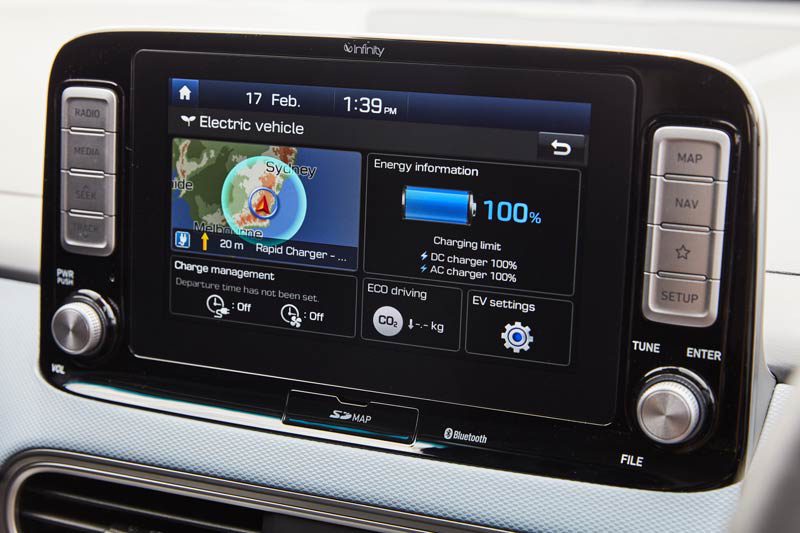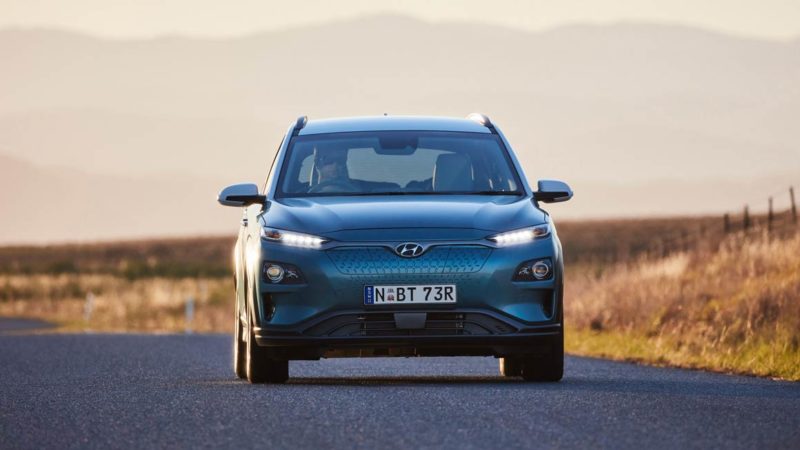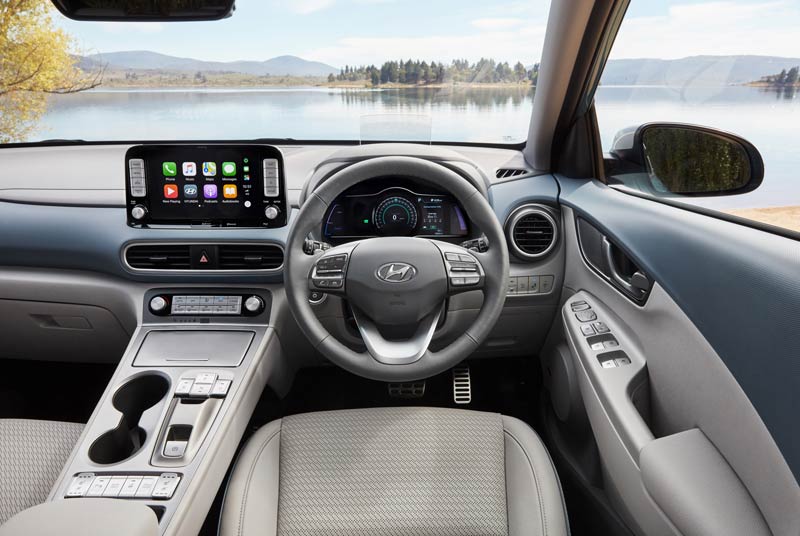Australians now officially have another electric vehicle to choose from thanks to South Korean carmaker Hyundai.
The all-electric long-range Kona compact SUV, with a 64kWh battery and a 449km “real” range, has been officially launched, joining its stablemate, the all-electric Ioniq that hit the market in late 2018.
The Ioniq became the first battery electric vehicle in Australia with a decent range to be priced under $50,000.
The Kona EV will be more expensive, given the bigger battery, and will start from $59,990 before on road costs for the Elite version and $64,990 for the Highlander.
It is another landmark development for the Australian EV market, where customers have been starved of available options because of the lack of models.
Until the Ioniq, the range has been limited to Tesla Model S and X, the electric BMW, and the new Jaguar I-Pace. More models, including the Tesla Model 3 and the new Nissan Leaf, are expected to arrive in July and August.
Overall passenger car sales in Australia have fallen 21 per cent, with speculation that customers are holding off on new purchases while they wait for their favourite EV option.
A recent Roy Morgan survey confirmed this, and the Kona is significant because compact SUVs are one of the few bright spots in the market, although most ICE (internal combustion engine) versions are much cheaper than the Kona electric.
Both the Hyundai electric cars features a max power output of 150kW, acceleration from 0-100km/hr in 7.6 seconds, a maximum speed of 167km.hr and the ability to recharge at a top rate of 100kW using a DC fast charger. Alternatively, customers can buy a 7.2kW charging adaptor for use at home or work .
This means that drivers will be able to charge the li-ion battery from 0-80% in under an hour (54 minutes to be precise) with the fast charger, and 9 hours 35 minutes at home or work using Hyundai’s optional home charger.

Drivers who don’t opt for the home charger can use instead ICCB-cable (in-cable control box) that Hyundai provides with the vehicle.
The 150kW power from the motor is more than any current Kona offers, delivering 375Nm peak torque for a fun a quick drive.
| Electric motor | 150 kW / 395 Nm |
| Battery & Charging | |
| Battery capacity | 64 kWh Li-ion Polymer |
| Charging via regenerative braking | Yes |
| Plug-in standard charging (AC) | Up to 7.2kW |
| Plug-in fast charging (DC) | Up to 100kW |
| Efficiency & Range | |
| Combined CO2 | Zero emissions |
| Electric driving efficiency – combined (Wh/km) | 153a (ADR 81/02 & NEDC) 131b real-world range (WLTP) |
| Electric range | 557 kma (ADR 81/02 & NEDC) 449 kmb (WLTP) |
The release for the Kona Electric has been slightly delayed, although Hyundai remains tight-lipped about the real reason for this. Reportedly, one factor holding its release on the Australian market until early April is the tuning of special suspension for Australia’s “uniquely challenging situations”.
A team of specialist engineers fine-tuned the Kona EV’s MacPherson Strut front and independent multi-link rear suspension after testing on local roads, ensuring its calibration for the low-riding centre of gravity of the electric vehicle.
Hyundai Australia’s senior manager for product planning Andrew Tuitahi said in a statement that “the low centre of mass brings lots of benefits that seem obvious, but also many challenges that were new to us.”
“This demanded different damper design and spring choices, to the end that Kona Electric shares very little in its ride and handling package with its petrol-powered sibling.”
“The Kona Electric powertrain and weight distribution required a very different approach to tuning compared with the conventionally engined Kona, and naturally defined a different brief,” Tuitahi said.
With a choice of 3 different driving modes – Normal, Eco and Eco+ the all-electric Kona is driven with a shift-by-wire system that adjusts the electric powertrain to suit everyday driving needs.
Paddles just behind the steering wheel allow the driver to control the amount of regenerative braking – the left paddle will halt the car completely. This allows for what is becoming known in the EV-world as “one-pedal” driving.
Smart sensors in the front of the vehicle combine with the regen system to assist with maximum energy recuperation in heavy traffic.
The Kona has an ICE equivalent, but does not have the same grille. It is available in five colours (Galactic Grey, Phantom Black, Ceramic Blue, Pulse Red, Lake Silver and Chalk White), with metallic options costing an extra $595.
Talking of extras – while electric cars do have considerably less maintenance costs compared to ICE vehicles, Hyundai still provides a service plan that costs $165 per service over five years.
It also comes with a battery warranty that is valid for 8 years or 160,000 kilometres.
Both versions of the all-electric Kona come with a decent array of driver assist features and other specifications (see below), with the Highlander offering an additional front park assist features, as well as neat inclusions like heated seats and sunroof.
It also has a nifty “heads up display” which is a clear display above the driver’s side dash that allows the driver to view basic information like speed and battery status.
| Kona Electric Elite | 150kW Electric Motor | |
| Key specifications: | ||
| 6 airbags | Auto dusk sensing headlights | 7” multimedia system |
| SmartSense™ including; | LED Daytime Running Lights (DRL) | Apple CarPlay compatibility |
| – Blind-Spot Collision Warning | Rear park assist system | Android Auto compatibility |
| – Driver Attention Warning | Rear view camera | Bluetooth connectivity |
| – Forward Collision-Avoidance Assist | Tyre Pressure Monitoring System | Heated exterior mirrors |
| – Forward Collision Warning | 17” alloy wheels w/ tyre mobility kit | Power folding exterior mirrors |
| – Lane Keeping Assist | Leather appointed interior | Front & rear power windows; |
| – Rear Cross-Traffic Collision Avoid. Assist | Electronic parking brake (EPB) | – driver’s one touch auto down |
| – Smart Cruise Control with Stop & Go | Shift By Wire (SBW) | Rear fog light |
| Electronic Stability Control (ESC) | Smart key & push button start | Side garnish insert |
| Anti-lock Braking System (ABS) | Climate control w/ auto defog | Skid plate – rear |
| Brake Assist System (BAS) | Rain sensing wipers | Driver & front pass. seat back pocket |
| Electronic Brakeforce Distribution (EBD) | Solar control glass w/ rear privacy | Luggage net |
| Hill-start Assist Control (HAC) | 7″ Supervision cluster | Roof Rails |
| Traction Control System (TCS) | Paddle shifters | In-cable control box (ICCB) |
| Vehicle Stability Management (VSM) | USB charging port | Hyundai Auto Link Premium |
| 8” satellite navigation system | Infinity premium audio system | Digital radio (DAB+) |
| Kona Electric Highlander | 150kW Electric Motor | |
| Key specifications: | ||
| Front park assist system | Glass sunroof | Heated steering wheel |
| LED headlights & front indicators | Air ventilated front seats | Head-up display (HUD) |
| LED taillights | Heated front seats | Electro-chromatic interior mirror |
| Wireless charging pad (Qi standard) | Power driver’s and passengers’ seats | No-cost option: Two-Tone Roof (note: deletes sunroof) |
| High Beam Assist |
The Driven will deliver its own driving review next week when we test out the all-electric Kona SUV.

Bridie Schmidt is associate editor for The Driven, sister site of Renew Economy. She has been writing about electric vehicles since 2018, and has a keen interest in the role that zero-emissions transport has to play in sustainability. She has participated in podcasts such as Download This Show with Marc Fennell and Shirtloads of Science with Karl Kruszelnicki and is co-organiser of the Northern Rivers Electric Vehicle Forum. Bridie also owns a Tesla Model Y and has it available for hire on evee.com.au.



